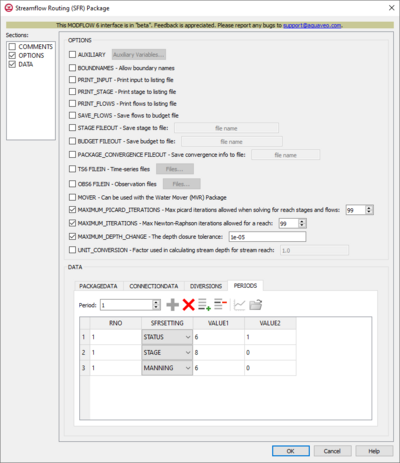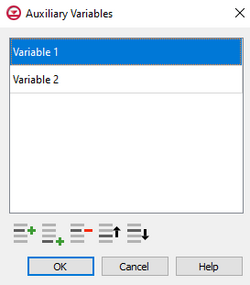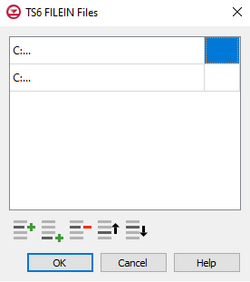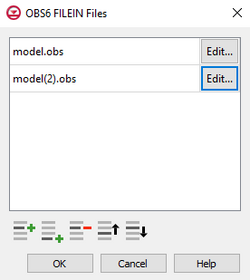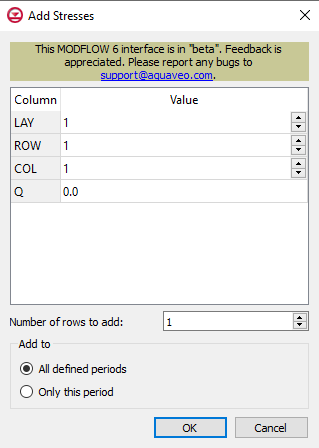GMS:MF6 SFR Package: Difference between revisions
No edit summary |
No edit summary |
||
| Line 81: | Line 81: | ||
{{Navbox GMS}} | {{Navbox GMS}} | ||
[[Category:MODFLOW 6|SFR]] | [[Category:MODFLOW 6|SFR]] | ||
[[Category:MODFLOW 6 Dialogs|sfr]] | |||
Latest revision as of 21:16, 15 March 2022
| MODFLOW 6 is currently in Beta release for GMS Some features and capabilities of MODFLOW 6 are still in development for GMS. |
| MODFLOW 6 | |
|---|---|
| Models & Tools | |
|
GWF Model GWT Model Cell Properties Dialog Zone File | |
| Packages | |
| Flow: | GNC, HFB, NPF |
| GWF: |
BUY, CHD, CSUB, DRN, EVT, GHB, LAK, MAW, MVR, OBS, RCH,RIV, SFR, STO, UZF, WEL |
| GWT: |
ADV, CNC, DSP FMI, IC, IST, LKT, MDT, MST, MVT, MWT, OBS, SFT, SRC,SSM, UZT |
| Other |
DIS, DISU, DISV, IMS, OC, TDIS, PEST |
The Streamflow Routing (SFR) Package dialog is accessed by double-clicking on the SFR package under a MODFLOW 6 simulation in the Project Explorer. It contains the following sections and options:
- Sections list – A list of sections that can be turned on or off:
- COMMENTS – Turn on to make the COMMENTS section visible.
- OPTIONS – Turn on to make the OPTIONS section visible.
- DATA – Turn on to make the DATA section visible. This section is on by default.
- COMMENTS section – Enter general alphanumeric comments. Comments entered here get written at the top of the file, preceded by a '#' symbol.
- OPTIONS section – Temporal options and settings:
- AUXILIARY – Click the Auxiliary Variables... button when this is turned on to bring up the Auxiliary Variables dialog.
- BOUNDNAMES – Allow boundary names. Turn on to indicate that the list of streamflow routing cells will be provided with the associative boundary names.
- PRINT_INPUT – Print input to listing file. Turn on to write the list of streamflow routing information to the listing file immediately after it is read.
- PRINT_STAGE – Print stage to listing file. If turned on, indicates that lake stages will be printed to the listing file for each stress period if "HEAD PRINT" is specified.
- PRINT_FLOWS – Print flows to listing file. Turn on to write the list of streamflow routing flow rates to the listing file for every stress period time step in which "BUDGET PRINT" is specified in Output Control.
- SAVE_FLOWS – Save flows to budget file. Turn on to write streamflow routing flow terms to the file specified with "BUDGET FILEOUT" in Output Control.
- STAGE FILEOUT – Indicates that the record corresponds to a specific stage. Also allows the written indication of stage information.
- BUDGET FILEOUT – Allows the specification of a binary output file to which desired flow terms will be written.
- PACKAGE_CONVERGENCE FILEOUT – Save package convergence info to a CSV file.
- TS6 FILEIN – Define time series files. Click the Files... button when this is turned on to bring up the TS6 FILEIN Files dialog.
- OBS6 FILEIN – Define observation files. Click the Files... button when this is turned on to bring up the OBS6 FILEIN Files dialog.
- MOVER – When turned on, indicates that the Streamflow Routing (SFR) Package, in this instance, can be used in collaboration with the Water Mover (MVR) Package.
- MAXIMUM_PICARD_ITERATIONS – Allows the written indication of the maximum number of Streamflow Routing Picard iterations allowed when solving for reach stages and flows as part of the GWF formulate step.
- MAXIMUM_ITERATIONS – Allows the written indication of the maximum number of Streamflow Routing Newton-Raphson iterations allowed for a reach.
- MAXIMUM_DEPTH_CHANGE – Allows the written indication of the depth closure tolerance.
- UNIT_CONVERSION – A conversion factor that is used in calculating stream depth for stream reach.
- DATA section – Contains a number of tabs, including:
- PACKAGEDATA
- Filter on Selected Cells –
 – Click to turn on filtering on the selected cells.
– Click to turn on filtering on the selected cells. - RNO – A value that defines the reach number associated with the specified PACKAGEDATA data.
- LAY – Used to specify which layer is being applied.
- ROW – Used to specify which row is being applied.
- COL – Used to specify which column is being applied.
- RLEN – A value that defines the reach length.
- RWID – A value that defines the reach width.
- RGRD – A value that defines the stream gradient (slope) across the reach.
- RTP – A value that defines the top elevation of the reach streambed.
- RBTH – A value that defines the thickness of the reach streambed.
- RHK – A value that defines the hydraulic conductivity of the reach streambed.
- MAN – A value that defines the Manning’s roughness coefficient for the reach.
- NCON – A value that defines the number of reaches connected to the reach.
- USTRF – A value that defines the fraction of upstream flow from each upstream reach that is applied as upstream inflow to the reach.
- NDV – A value that defines the number of downstream diversions for the reach.
- AUX – These columns represent the values of the auxiliary variables for each stream reach, which previously may have been created if the AUXILIARY option was set.
- BOUNDNAME – This column represents the names of the stream reach cells, and will appear if the BOUNDNAMES option was set.
- Add Rows... – Allows the inserting of additional rows into the PACKAGEDATA table.
- Filter on Selected Cells –
- CONNECTIONDATA
- RNO – A value that defines the reach number associated with the specified CONNECTIONDATA data.
- IC – A value that defines the reach number of the reach connected to the current reach and whether it is connected to the upstream or downstream end of the reach.
- Add Rows... – Allows the inserting of additional rows into the CONNECTIONDATA table.
- DIVERSIONS
- RNO – A value that defines the reach number associated with the specified DIVERSIONS data.
- IDV – A value that defines the downstream diversion number for the diversion for reach RNO.
- ICONR – A value that defines the downstream reach that will receive the diverted water.
- CPRIOR – A value that defines the the prioritization system for the diversion. There are multiple options that can be selected from a drop-down.
- Add Rows... – Allows the inserting of additional rows into the DIVERSIONS table.
- PERIODS
- Period drop-down – Use the Increment Up and Down
 buttons to select the desired period.
buttons to select the desired period. - Define Period
 – If no period is defined, click to make the spreadsheet editable.
– If no period is defined, click to make the spreadsheet editable. - Delete Period
 – Click to delete the existing period.
– Click to delete the existing period. - Add Rows
 – Click to bring up the Add Stresses dialog.
– Click to bring up the Add Stresses dialog. - Delete Rows
 – Click to bring up a dialog with three options:
– Click to bring up a dialog with three options:
- Delete from All Periods – Click to delete matching stresses from all periods.
- Delete from Just This Period – Click to delete matching stresses from just this period.
- Plot All Periods
 – Click to bring up the XY Series Editor dialog. Requires that a cell be selected in the table.
– Click to bring up the XY Series Editor dialog. Requires that a cell be selected in the table. - Open Time Series
 – Click to bring up the
– Click to bring up the - RNO – A value that defines the reach number associated with the specified PERIODS data.
- SFRSETTING – Information that is linked to keywords and values. There are multiple options that can be selected from a drop-down.
- VALUE1 – Value to be entered in relation to the specific project.
- VALUE2 – Value to be entered in relation to the specific project.
- Period drop-down – Use the Increment Up and Down
- PACKAGEDATA
Contents
Auxiliary Variables Dialog
The Auxiliary Variables dialog is accessed by clicking Auxiliary Variables... in the Options section of many package dialogs. It is used to define an array of one or more auxiliary variable names. It contains the following sections and buttons:
- At the top is an unlabeled section listing all of the variables, one per line. Double-click on a variable name to rename it.
- Insert Row
 – Click to insert a row above the currently-selected row.
– Click to insert a row above the currently-selected row. - Add Row
 – Click to add a row below the currently-selected row.
– Click to add a row below the currently-selected row. - Delete Row
 – Click to delete the selected row.
– Click to delete the selected row. - Move Up
 – Move the selected row up.
– Move the selected row up. - Move Down
 – Move the selected row down.
– Move the selected row down.
Note that each variable name must be unique. If two or more variables share a name, variables added since opening the dialog will not be saved.
Time Series Files Dialog
The Time Series Files dialog is accessed by clicking Time Series Files... in the Options section of many of the package dialogs. It is used to define an array of one or more time series files. It contains the following sections and buttons:
- At the top is an unlabeled section listing all of the time series files, one per line.
- Double-click on the first field to see the full file path and name.
- Click Edit... to open the time series file.
- Insert Row
 – Click to insert a row above the currently-selected row.
– Click to insert a row above the currently-selected row. - Add Row
 – Click to add a row below the currently-selected row.
– Click to add a row below the currently-selected row. - Delete Row
 – Click to delete the selected row.
– Click to delete the selected row. - Move Up
 – Move the selected row up.
– Move the selected row up. - Move Down
 – Move the selected row down.
– Move the selected row down.
Observation Files Dialog
The Observation Files dialog is accessed by clicking Observations... in the Options section of many of the package dialogs. It is used to define an array of one or more observation files. It contains the following sections and buttons:
- At the top is an unlabeled section listing all of the observation files, one per line.
- Double-click on the first field to see the full file path and name.
- Click Edit... to open the Observations (OBS) Dialog.
- Insert Row
 – Click to insert a row above the currently-selected row.
– Click to insert a row above the currently-selected row. - Add Row
 – Click to add a row below the currently-selected row.
– Click to add a row below the currently-selected row. - Delete Row
 – Click to delete the selected row.
– Click to delete the selected row. - Move Up
 – Move the selected row up.
– Move the selected row up. - Move Down
 – Move the selected row down.
– Move the selected row down.
Add Stresses Dialog
The Add Stresses dialog is accessed by clicking Add Rows ![]() in the Periods section of several MODFLOW 6 package dialogs. It contains the following sections and options:
in the Periods section of several MODFLOW 6 package dialogs. It contains the following sections and options:
- Table – Table Options differ according to each package. See chart below.
- Number of rows to add – Use the Increment Up and Down
 buttons to select the desired number of rows to add.
buttons to select the desired number of rows to add.
- Add to section – Radio buttons with the following options:
- All defined periods – Select to add the rows to all defined periods.
- Only this period – Select to add the rows to only this period.
| Package | Add Stresses Dialog Table Options | ||
|---|---|---|---|
| CHD |
| ||
| DRN |
| ||
| GHB |
| ||
| HFB |
| ||
| LAK |
| ||
| MAW |
| ||
| RIV |
| ||
| SFR |
| ||
| UZF |
| ||
| WEL |
|
Related Topics
| GMS – Groundwater Modeling System | ||
|---|---|---|
| Modules: | 2D Grid • 2D Mesh • 2D Scatter Point • 3D Grid • 3D Mesh • 3D Scatter Point • Boreholes • GIS • Map • Solid • TINs • UGrids | |
| Models: | FEFLOW • FEMWATER • HydroGeoSphere • MODAEM • MODFLOW • MODPATH • mod-PATH3DU • MT3DMS • MT3D-USGS • PEST • PHT3D • RT3D • SEAM3D • SEAWAT • SEEP2D • T-PROGS • ZONEBUDGET | |
| Aquaveo | ||
